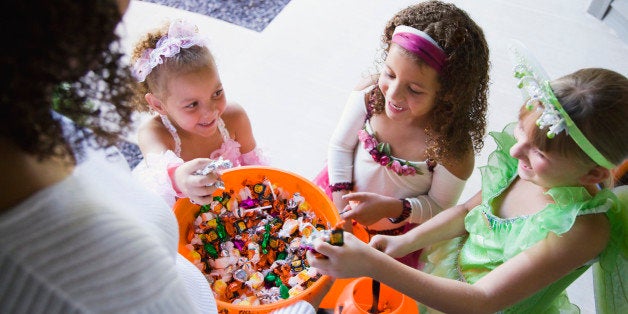
Halloween trick or treating is many things: a tradition of American childhood, a chance for kids and adults alike to express their creativity, a day when it's OK for everyone to eat candy. Here's something else it's inadvertently become: a measure of how far apart many Americans now live from their neighbors -- and as such, a proxy for community.
Consider the latest trick-or-treat trend popping up in places all across the nation: the so-called "trunk or treat," a tradition where instead of the usual, foot-powered, door-to-door ritual, parents drive to the parking lot of a predetermined local institution -- a church, a school, a performing arts center -- park their cars in tailgate formation, and the kids trick-or-treat from car to car. Trunk or treats, which started popping up last year, are gaining momentum this year in suburban and rural counties across the nation.
The reasons driving this trend are many: parents feel it's safer for small children to meet in a predetermined area than walking at night on streets with traffic; it reduces fear of strangers or nefarious neighbors giving out tainted candy and quells the oft-held fear of abductions. It becomes a social event for the parents.
But in a growing number of suburban communities, the tradition has become a forced necessity due to our pattern of sprawl. Houses in many modern subdivisions and communities are spread so far apart that walking to more than one or two houses, for young children, is simply too tiring. There are often few sidewalks in these communities and plenty of wide, curving streets that encourage cars to go faster, adding a safety risk. Then there's the collection problem: for any self-respecting trick-or-treater, there's just no way low-density arrangement patterns yield enough loot.
These issues have reduced the enthusiasm for going door-to-door in many of today's low-density suburban communities. Annette Lee, a reproductive endocrinologist in a large-lot community in Worcester Township, Pennsylvania, discovered that she and her husband only need to buy a single bag of candy to welcome would-be trick or treaters into their home--and even then, they are often lucky if the doorbell rings once. "Nobody wants to walk," says Lee; the only visitors they tend to get, she says, are the ones whose parents drive them and wait in the driveway.
Where Lee and her family used to live, in Boonton Township, New Jersey, lot sizes were similarly large, but there, the township came up with a different solution: parents would drive to the parking lot of the K-8 school, park their cars in tailgate formation, and kids would trick-or-treat from car to car. The community loved it: families would decorate their cars--dry ice, cobwebs and all -- and parents got to socialize. The kids, meanwhile, had a great time -- and found it far more lucrative from a candy-collection perspective.
Trunk-or-treats are just one of many novel twists on the time-honored door-to-door tradition. In Brooklyn's family-friendly Park Slope, kids trick-or-treat along the neighborhood's commercial corridor of Seventh Avenue, going from store to store instead of from house to house. In New York and many other big cities, big apartment buildings -- which have the best candy-per-square-foot ratio of any place -- have 'opt-in' systems whereby children know to knock on the doors of neighbors who've chosen to participate, and ignore those that have opted out.
In many suburbs, the increasing popularity of the trunk-or-treat is also an indicator of residential design that discourages walking of any kind. Houses are built further apart in more modern communities, there are often no sidewalks, and every trip requires a car; it's perhaps not surprising that while half of kids used to walk to school in the 1970s, now fewer than 15 percent do. It's all a measure of how far we have come from tight-knit, Wonder Years-era communities that once grew out of physical proximity that when it comes time for that most treasured, bipedal childhood neighborhood tradition -- knocking on doors in costume each October 31 -- parents are now having to jerry-rig that kind of tight-knit neighborhood themselves, out of cars.
In the community where Lee and her family now live, enterprising trick-or-treaters have found another solution: they decamp for a much denser neighborhood nearby. There, Lee says, home-owners get so many trick-or treaters -- many who don't even live there but travel in from other areas -- that they "have to buy $100 in Halloween candy."
Leigh Gallagher is an assistant managing editor at Fortune magazine and author of The End of the Suburbs: Where the American Dream is Moving